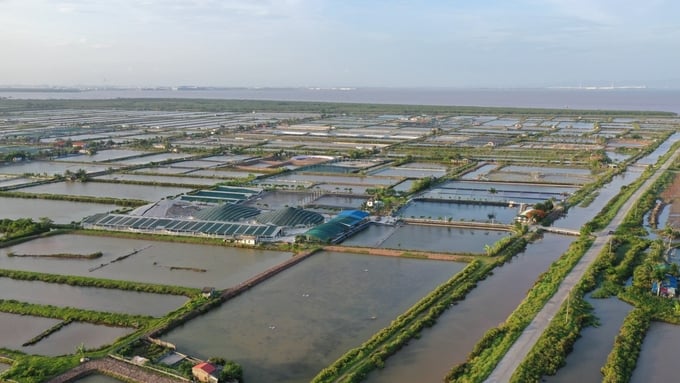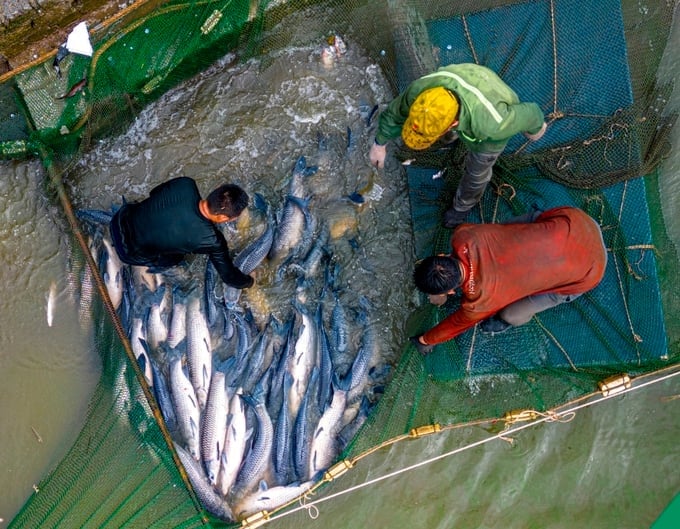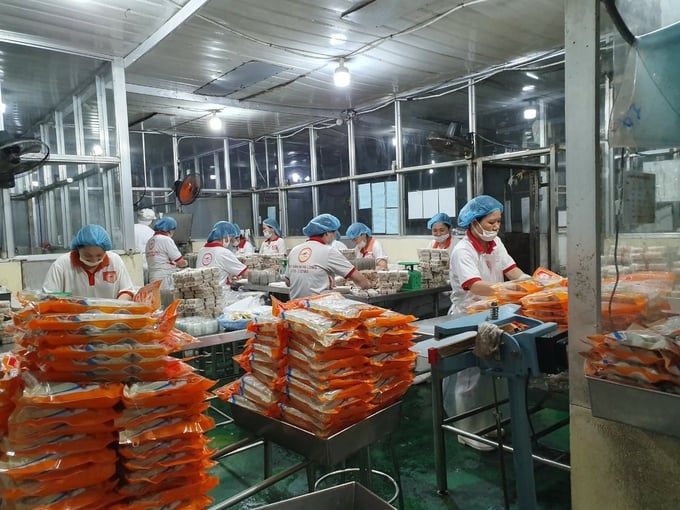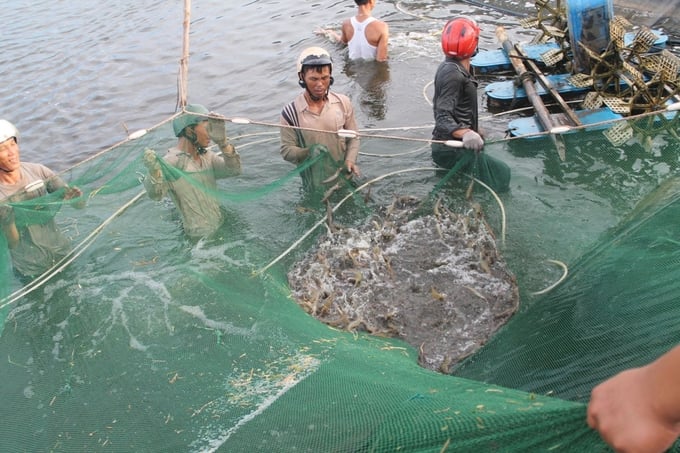November 20, 2025 | 22:39 GMT +7
November 20, 2025 | 22:39 GMT +7
Hotline: 0913.378.918
November 20, 2025 | 22:39 GMT +7
Hotline: 0913.378.918

High-tech white shrimp farming area in Tan Thanh ward, Duong Kinh district. Photo: Dinh Muoi.
Hai Phong is a city with many potentials and advantages to develop a comprehensive fisheries economy in aquaculture, exploitation, processing and fisheries logistics services with an aquaculture area of more than 12 thousand ha, and an aquaculture potential area of more than 42 thousand ha.
Hai Phong's river system has a quite high density, formed by the main river systems of Bach Dang, Da Bac, Cam,... characterized by the slow flow and large amounts of silt, often forming mudflats, lagoons or low areas along rivers, which are favourable for aquaculture.
Therefore, aquaculture in Hai Phong develops strongly in all three kinds of water areas: fresh, brackish, and salty; output value increases steadily every year with highly effective farming species such as black tiger shrimp, white leg shrimp, mud crabs, marine fish... Consequently, Hai Phong has been implementing structural transformation and development projects following the economic farm model, concentrated production areas, and aquaculture applying high technology.
With the advantages of natural conditions and flexible mechanisms and policies in agricultural development, Hai Phong has certain strengths in competing for seafood exports in the international arena... However, currently, this advantage has not been fully exploited and is still open for more development.
As an industrial city, agricultural production, especially seafood, has always received a certain amount of attention from Hai Phong City over the years. Basically, Hai Phong's agricultural sector is developing quite comprehensively and sustainably in the direction of concentrated commodity production, moving towards ecological agriculture and applying high technology.

Black carp raising in Lap Le commune, Thuy Nguyen district. Photo: Dinh Muoi.
In the field of fisheries exploitation, to realize the goal of building Hai Phong into the country's major fishing centre associating with the Gulf of Tonkin fishing grounds. In recent years, the city's fishing boats have been restructured in the direction of gradually reducing the near-shore fishing fleet, increasing the fleet of vessels exploiting offshore waters with new and modern equipment.
The city's key and typical products have increasing value and competitiveness in the market. This includes a series of key products such as: marine fish, squid, freshwater fish (tilapia, grass carp), brackish water fish (bass, black carp), traditional fish sauce, Aga products, seafood cakes (fish cakes, squid cakes), sun-dried products, sardines,...
However, the export of aquatic products to the world market is still limited. Up to now, Hai Phong's main export products are aquatic products and products processed from aquatic products such as: Surimi (ground fish meat), octopus, dried sea cucumber, frozen boiled clams, oyster intestines, dried shrimp, iced sea fish, white leg shrimp, dried sea shrimp, Nereididaes...
These products are concentrated mainly in 5 businesses: Viet Truong Company Limited, Seasaifico Hai Phong Seafood Processing Enterprise, Ha Long Service and Import-Export Joint Stock Company, Seaprodex Company Hai Phong Branch, Binh Oanh Company, typically exported to traditional markets such as countries in the ASEAN region, China, Korea, EU, Taiwan,...
Although there is great potential and the Covid-19 epidemic has been controlled, according to statistics from the Department of Agriculture, Forestry and Fisheries Quality Management Region I, in 2022, the amount of seafood products Hai Phong exports to the EU, China, Japan, Korea, ASEAN markets,... only reaches nearly 10 thousand tons.

Basic processing enterprises are still small-scale, many of which cannot meet export requirements. Photo: Dinh Muoi.
In the first 7 months of 2023, Hai Phong's total seafood output exported to the above-mentioned market reached just over 7 thousand tons. The main export products are: iced and frozen aquatic products (sea fish, oysters); dried seafood (fish, sea cucumber, sea shrimp); frozen octopus; frozen boiled clams; surimi; live Nereididaes. Meanwhile, for the whole year 2022, Hai Phong's aquaculture and exploitation output reached more than 192 million tons, of which seafood exploitation alone accounted for more than 115 thousand tons.
From the above reality, Hai Phong has great resources and potential to export agricultural and aquatic products to international markets. However, the number of enterprises operating in the field of processing and export is still limited. In addition to aquatic products and merchandised processed from aquatic products serving export, crop and livestock products are only produced to meet domestic consumption requirements and are not yet capable of exporting.

Although the province possesses great potential, Hai Phong's seafood export output in recent years has not been much. Photo: Dinh Muoi.
Besides, the unpredictable developments of the world macroeconomy will be significant challenges for the export production of Hai Phong city. International economic integration brings many advantages and opportunities, but at the same time, there are also many potential challenges for the export of agricultural, forestry and seafood goods.
In addition, there also needs to be specific policies to support and encourage agricultural production to increase scientific and technical content in all stages from production, harvesting, and preservation to processing of agricultural products. This is to gradually improve productivity and quality along with lowering product costs.
Translated by Hoang Duy

(VAN) This is the study conducted by IRRI and Can Tho University on the rice straw value chain in Mekong Delta showing an economic potential of more than 6.6 trillion VND/year.

(VAN) By participating in cooperative economics, many farmers in Tay Ninh have overcome hardship, mastered clean dragon fruit cultivation techniques.

(VAN) The crossbreeding program in the former Binh Dinh province (now part of Gia Lai) has shown signs of decline, and urgent measures are needed to revive it and sustain past achievements.

(VAN) The agricultural sector agreed on a roadmap to pilot the MRV protocol and expand low-emission rice production from the 2025-2026 winter-spring crop.

(VAN) Agricultural extension officers in Quang Ninh do more than transmit knowledge; they have become a steadfast support system for farmers on the path to sustainable agricultural development.

(VAN) The development of a high-quality beef cattle herd has brought major benefits to livestock farmers, creating jobs and enabling better use of agricultural by-products.

(VAN) In the eastern region of Gia Lai, crossbred cattle now account for 93%, forming a high-quality beef herd and establishing a recognized brand, the result of 35 years of persistent effort.